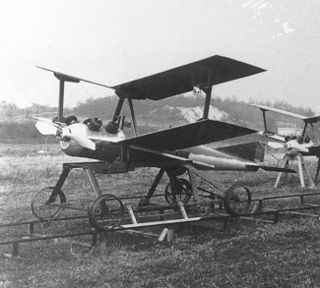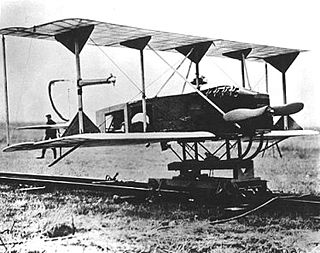History
In October 1914, Dr. Wilhelm von Siemens proposed what became was to become known as the Siemens torpedo glider, a wire-guided flying missile that would have comprised a naval torpedo with an attached airframe. It was not intended that it be flown into a target; rather, at a suitable altitude and position, a signal would have been transmitted which would cause the airframe components to detach from the torpedo which would then enter the water and continue towards its target. Guidance signals were to be transmitted through a thin copper wire unrolled from a 2.5 mi (4.0 km) reel above the fuselage, and guide flares were to be carried to help control.
Siemens-Schuckertwerke was already occupied with remote-controlled anti-shipping motorboats (the FL-boats or Fernlenkboote), and so had some experience in the field of remote control.
Flight testing was performed under the supervision of Dipl. Ing. Dorner from January 1915 onwards, using airships as carriers. Different types of biplane and monoplane airframes were tested, to which a torpedo was fitted, before a biplane layout was adopted due to its greater carrying ability. The last test flight was performed on August 2, 1918. On this flight a 1,000 kilograms (2,200 lb) biplane glider was launched from Zeppelin LZ 80 (L 35). The glider was released from 1,500 metres (4,900 ft) over the Havel river and worked as expected until its control wire that attached the glider to the Zeppelin snapped and the glider spun out of control.
It was planned to use the Siemens-Schuckert R.VIII bomber as a carrier craft, but the Armistice stopped the project.

A biplane is a fixed-wing aircraft with two main wings stacked one above the other. The first powered, controlled aeroplane to fly, the Wright Flyer, used a biplane wing arrangement, as did many aircraft in the early years of aviation. While a biplane wing structure has a structural advantage over a monoplane, it produces more drag than a monoplane wing. Improved structural techniques, better materials and higher speeds made the biplane configuration obsolete for most purposes by the late 1930s.

A military aircraft is any fixed-wing or rotary-wing aircraft that is operated by a legal or insurrectionary military of any type. Military aircraft can be either combat or non-combat:

The German aircraft carrier Graf Zeppelin was the lead ship in a class of two carriers of the same name ordered by the Kriegsmarine of Nazi Germany. She was the only aircraft carrier launched by Germany and represented part of the Kriegsmarine's attempt to create a well-balanced oceangoing fleet, capable of projecting German naval power far beyond the narrow confines of the Baltic and North Seas. The carrier would have had a complement of 42 fighters and dive bombers.

A glide bomb or stand-off bomb is a standoff weapon with flight control surfaces to give it a flatter, gliding flight path than that of a conventional bomb without such surfaces. This allows it to be released at a distance from the target rather than right over it, allowing a successful attack without exposing the launching aircraft to anti-aircraft defenses near the target. Glide bombs can accurately deliver warheads in a manner comparable to cruise missiles at a fraction of the cost—sometimes by installing flight control kits on simple unguided bombs—and they are very difficult for surface-to-air missiles to intercept due to their tiny radar signatures and short flight times. The only effective countermeasure in most cases is to shoot down enemy aircraft before they approach within launching range, making glide bombs very potent weapons where wartime exigencies prevent this.

The mechanical structure of an aircraft is known as the airframe. This structure is typically considered to include the fuselage, undercarriage, empennage and wings, and excludes the propulsion system.
This is a list of aviation-related events from 1916:

A parasite aircraft is a component of a composite aircraft which is carried aloft and air launched by a larger carrier aircraft or mother ship to support the primary mission of the carrier. The carrier craft may or may not be able to later recover the parasite during flight.
This is a list of aviation-related events during the 19th century :

The Kettering Bug was an experimental unmanned aerial torpedo, a forerunner of present-day cruise missiles. It was capable of striking ground targets up to 75 miles (121 km) from its launch point, while traveling at speeds of 50 miles per hour (80 km/h). A successful test flight was made in October, 1918. The Bug's costly design and operation inspired Dr. Henry W. Walden to create a rocket that would allow a pilot to control the rocket after launch with the use of radio waves. The British radio controlled weapons of 1917 were secret at this time. These designs were forerunners of modern-day missiles.

The Hewitt-Sperry Automatic Airplane was a project undertaken during World War I to develop a flying bomb, or pilotless aircraft capable of carrying explosives to its target. It is considered by some to be a precursor of the cruise missile.

An aerial torpedo is a torpedo launched from a torpedo bomber aircraft into the water, after which the weapon propels itself to the target.

The Arado Ar 95 was a single-engine reconnaissance and patrol biplane designed and produced by the German aircraft manufacturer Arado.

The Graf Zeppelin-class aircraft carriers were four German Kriegsmarine aircraft carriers planned in the mid-1930s by Grand Admiral Erich Raeder as part of the Plan Z rearmament program after Germany and Great Britain signed the Anglo-German Naval Agreement. They were planned after a thorough study of Japanese carrier designs. German naval architects ran into difficulties due to lack of experience in building such vessels, the situational realities of carrier operations in the North Sea and the lack of overall clarity in the ships' mission objectives.

Project Kingfisher was a weapons-development program initiated by the United States Navy during the latter part of World War II. Intended to provide aircraft and surface ships with the ability to deliver torpedoes to targets from outside the range of defensive armament, six different missile concepts were developed; four were selected for full development programs, but only one reached operational service.

The Pratt-Read LBE-1 was a prototype glide bomb, or "Glomb", developed for the United States Navy during World War II. Although there were high hopes for the concept, the limitations of the Glomb led to the production contract for the LBE-1 being reduced, then cancelled, and only four examples of the type were ever built.

The Piper LBP was a glide bomb, or "Glomb", developed by Piper Aircraft for the United States Navy during World War II. Developed as one of three "Glomb" aircraft, the inherent limitations of the Glomb and the technology of the time, combined with difficulties encountered in testing of the prototype, led to the production contract for the LBP-1 being reduced, then cancelled, with none of the Glomb aircraft ever seeing operational service.

The Taylorcraft LBT was a glider designed and built by Taylorcraft during World War II, in response to a United States Navy requirement for a glide bomb. One of three prototype "Glomb" models ordered by the Navy, the LBT suffered from technical and performance difficulties, and was cancelled early in production, none of the aircraft seeing operational service.

The AAM-N-5 Meteor was an early American air-to-air missile, developed by the Massachusetts Institute of Technology and Bell Aircraft for the United States Navy. Initially, both air-launched and ship-launched versions were considered. Versions designed for launch from carrier-based aircraft proceeded to the flight testing stage before the project was cancelled.

The pioneer era of aviation was the period of aviation history between the first successful powered flight, generally accepted to have been made by the Wright Brothers on 17 December 1903, and the outbreak of the First World War in August 1914.
The Imperial German Army Zeppelin LZ 80 (L-35) was a R-class World War I zeppelin.















